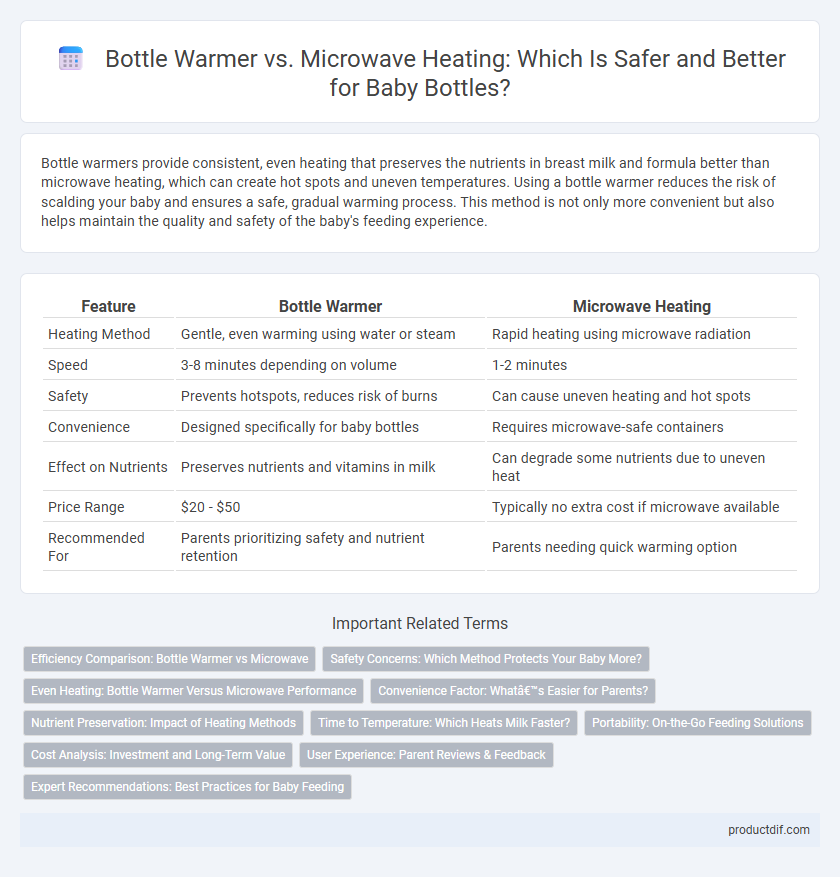Bottle warmers provide consistent, even heating that preserves the nutrients in breast milk and formula better than microwave heating, which can create hot spots and uneven temperatures. Using a bottle warmer reduces the risk of scalding your baby and ensures a safe, gradual warming process. This method is not only more convenient but also helps maintain the quality and safety of the baby's feeding experience.
Table of Comparison
| Feature | Bottle Warmer | Microwave Heating |
|---|---|---|
| Heating Method | Gentle, even warming using water or steam | Rapid heating using microwave radiation |
| Speed | 3-8 minutes depending on volume | 1-2 minutes |
| Safety | Prevents hotspots, reduces risk of burns | Can cause uneven heating and hot spots |
| Convenience | Designed specifically for baby bottles | Requires microwave-safe containers |
| Effect on Nutrients | Preserves nutrients and vitamins in milk | Can degrade some nutrients due to uneven heat |
| Price Range | $20 - $50 | Typically no extra cost if microwave available |
| Recommended For | Parents prioritizing safety and nutrient retention | Parents needing quick warming option |
Efficiency Comparison: Bottle Warmer vs Microwave
Bottle warmers provide consistent, gentle heat that evenly warms milk, preserving essential nutrients and preventing hot spots, unlike microwave heating which often results in uneven temperatures and potential nutrient degradation. Microwave heating is faster but can create dangerous hotspots that may burn a baby's mouth, whereas bottle warmers typically take longer but ensure safety and uniform warmth. Efficiency in warming depends on balancing speed with nutrient preservation and safety, with bottle warmers generally offering superior performance for sensitive baby bottles.
Safety Concerns: Which Method Protects Your Baby More?
Bottle warmers offer precise temperature control, reducing the risk of hot spots that can cause burns or destroy essential nutrients in breast milk or formula. Microwave heating often results in uneven warming, increasing the chance of dangerous temperature fluctuations that can harm your baby's delicate mouth and throat. Using a bottle warmer is generally safer as it ensures consistent, gentle warming, preserving nutrient integrity while minimizing burn risks.
Even Heating: Bottle Warmer Versus Microwave Performance
Bottle warmers provide consistent and even heating by surrounding the bottle with warm water, preventing hot spots that can occur in microwave heating. Microwaves heat unevenly, creating potential burn risks and nutrient loss in baby formula or breast milk. Using a bottle warmer ensures safer and more uniform temperature distribution for baby feeding.
Convenience Factor: What’s Easier for Parents?
Bottle warmers provide precise temperature control and consistent warming, making them a hassle-free option for parents during nighttime feedings. Microwave heating, though faster, often results in uneven warmth and requires careful monitoring to avoid overheating or hot spots that can harm the baby. For busy parents seeking convenience, bottle warmers offer a safer, more reliable method with minimal effort.
Nutrient Preservation: Impact of Heating Methods
Bottle warmers maintain a consistent temperature that preserves essential nutrients and vitamins in baby formula or breast milk, reducing the risk of hot spots that can degrade sensitive components. Microwave heating can create uneven heat distribution, leading to nutrient loss and potential burns in localized areas. Choosing bottle warmers over microwave heating ensures safer, nutrient-efficient preparation of baby feeding bottles.
Time to Temperature: Which Heats Milk Faster?
Bottle warmers typically heat milk more evenly and efficiently than microwave heating, reaching the desired temperature in about 3 to 5 minutes. Microwaves can heat quickly, often within 1 to 2 minutes, but risk uneven heating and hot spots that may harm the baby. For consistent and safe temperature control, bottle warmers are preferred despite taking slightly longer than microwave methods.
Portability: On-the-Go Feeding Solutions
Bottle warmers offer greater portability than microwave heating, featuring compact designs ideal for on-the-go feeding solutions. Many models include rechargeable batteries or car adapters, enabling warm milk or formula anywhere without relying on an electrical outlet. Microwave heating requires access to a microwave, making it less convenient for travel or outdoor use.
Cost Analysis: Investment and Long-Term Value
A bottle warmer typically involves an upfront investment ranging from $20 to $50, offering consistent temperature control and energy efficiency that can reduce long-term costs compared to microwave heating, which requires no additional device purchase but may lead to uneven warming and potential nutrient loss. Microwaves generally consume more electricity per use and risk overheating bottles, potentially necessitating replacement, while bottle warmers provide a safer, more precise warming process that preserves nutrient quality and extends the usability of baby feeding products. Over time, the initial cost of a bottle warmer can be offset by improved feeding experiences and reduced risks of bottle damage, ensuring better value for parents focused on both safety and convenience.
User Experience: Parent Reviews & Feedback
Parents report that bottle warmers provide consistent, even heating that preserves nutrient quality and prevents hot spots, unlike microwave heating which can cause uneven temperatures and risk burns. Many value the convenience and safety features of bottle warmers, such as automatic shut-off and preset temperature controls, enhancing peace of mind during late-night feedings. User feedback highlights that although microwave heating is faster, bottle warmers offer a gentler warming process preferred for sensitive infant formulas and breast milk.
Expert Recommendations: Best Practices for Baby Feeding
Experts recommend using bottle warmers over microwave heating for baby feeding due to consistent temperature control and safety. Bottle warmers evenly heat breast milk or formula, preserving vital nutrients while avoiding hot spots that can cause burns. Pediatricians emphasize avoiding microwave heating to prevent nutrient degradation and uneven warming, ensuring optimal nutrition and safety for infants.
Bottle Warmer vs Microwave Heating Infographic

 productdif.com
productdif.com